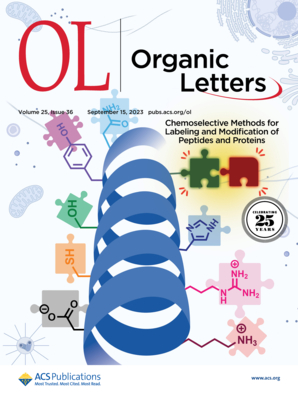Triphenylene Diazocines: Butterfly-Type Rigid Photoswitches with Annulated Aromatic Ring Systems and Increased Switching Amplitude
IF 4.9
1区 化学
Q1 CHEMISTRY, ORGANIC
引用次数: 0
Abstract
Azobenzenes are arguably the most frequently used photoswitches, but systems in which the benzene units are replaced by larger π systems are rare. Azonaphthalene is known, but the next higher homologue azoanthracene already undergoes irreversible intramolecular cycloaddition during photoisomerization. Such side reactions are not possible with rigid diazocines. In the present work, we have succeeded in integrating triphenylene groups into diazocines, making them the azo switches with the largest aromatic, annulated ring systems published to date. Both the unsubstituted system and several derivatives are easy to access. The extension of the π systems results in a larger molecular switching amplitude compared to parent diazocine, which should lead to better force transmission to the environment in material applications. The switching wavelengths are shifted bathochromically into the visible range, although the photostationary equilibria are decreased. Potential applications include switchable liquid crystals, mechanophores, photoactuators, and many other responsive materials. Particularly noteworthy is the 4-fold substitution of the system, which allows incorporation into larger systems, e.g. as multifunctional cross-linkers in polymers or as building blocks in COFs and MOFs.

三苯基重氮嘧啶:具有环芳香环系统和增加开关振幅的蝴蝶型刚性光开关
偶氮苯可以说是最常用的光开关,但是用更大的π系统取代苯单元的系统很少见。偶氮萘是已知的,但下一个更高的同系物偶氮蒽在光异构过程中已经经历了不可逆的分子内环加成。刚性重氮类药物不可能发生这种副反应。在目前的工作中,我们已经成功地将三苯基整合到重氮嘧啶中,使它们成为迄今为止发表的最大的芳香环系统的偶氮开关。未取代体系和一些衍生物都很容易获得。与母体重氮嘧啶相比,π系统的扩展导致更大的分子开关振幅,这将导致在材料应用中更好地向环境传递力。开关波长被移到可见光范围,虽然光稳态平衡降低。潜在的应用包括可切换液晶、机械载体、光致动器和许多其他响应材料。特别值得注意的是该体系的4倍取代,它允许合并到更大的体系中,例如作为聚合物中的多功能交联剂或作为COFs和mof的构建块。
本文章由计算机程序翻译,如有差异,请以英文原文为准。
求助全文
约1分钟内获得全文
求助全文
来源期刊

Organic Letters
化学-有机化学
CiteScore
9.30
自引率
11.50%
发文量
1607
审稿时长
1.5 months
期刊介绍:
Organic Letters invites original reports of fundamental research in all branches of the theory and practice of organic, physical organic, organometallic,medicinal, and bioorganic chemistry. Organic Letters provides rapid disclosure of the key elements of significant studies that are of interest to a large portion of the organic community. In selecting manuscripts for publication, the Editors place emphasis on the originality, quality and wide interest of the work. Authors should provide enough background information to place the new disclosure in context and to justify the rapid publication format. Back-to-back Letters will be considered. Full details should be reserved for an Article, which should appear in due course.
 求助内容:
求助内容: 应助结果提醒方式:
应助结果提醒方式:


